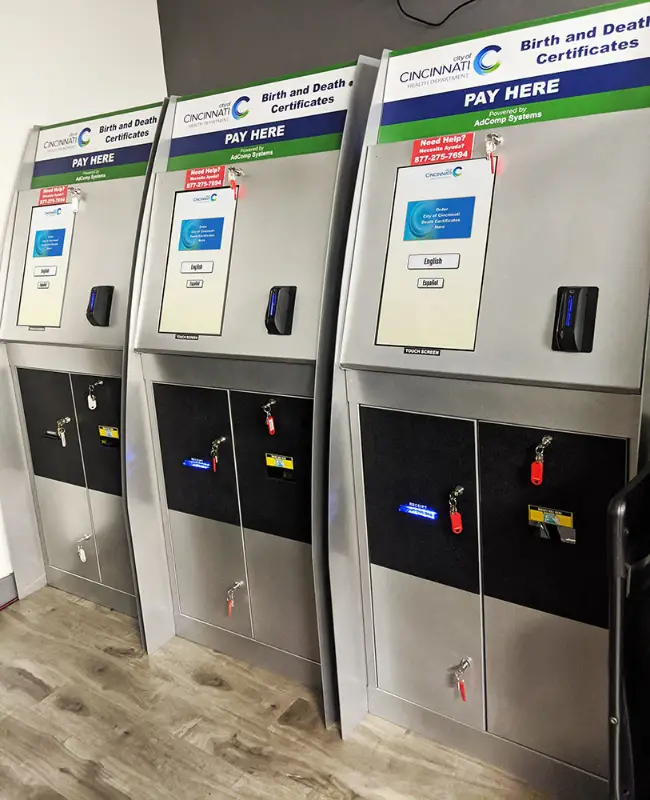
Client: Cincinnati Health Department Vital Records
Location: Cincinnati, OH
Population: 301,394 (2019 est.)
AdComp Client Since: 2016
Case Study Highlights
- Self-service options allow office to continue providing services amid pandemic
- Electronic forms are more efficient than handwritten applications
- Web app reports help combat identity theft
- Manual handling of cash is risky and cumbersome—kiosks are better
The Challenges: Handwritten Applications, Customer Volume & ID Theft
Around 2010, the CHD Vital Records was authorized to issue birth certificates to anyone born in Ohio. The office also issues certificates for deaths that occur within city limits. Typically, customers would fill out and submit handwritten forms that were often hard to decipher. So, the office needed a solution to manage an increase in volume of customers and eliminate handwritten applications.
Another challenge was expanding services to multiple locations and corresponding staffing considerations. CHD Vital Records did not want a single staff member to be responsible for both cash and certificates, so the office had to place several employees at each location. This would strain the office’s staff and resources.
Further, since Ohio is an open state — which means that an individual can request anybody’s birth or death certificate without providing ID — the office also wanted to implement security measures to handle identity theft.
To address these challenges, the CHD Vital Records needed a user-friendly system to streamline workflows and improve safety.
The Solution: How CHD Vital Records Used AdComp’s Kiosks & Web Portal
To expand its services and manage a high volume of orders, CHD Vital Records partnered with AdComp Systems Group to launch a network of six self-service kiosks and a web portal. With both cloud-based solutions in place, customers could either order a certificate in person at the kiosk or online using the website.
AdComp’s bilingual Justified Automated Cashiering Kiosk (JACK) machines helped support expansion efforts and provide all citizens, including many cash-paying customers, with an accessible solution to order a certificate in person. The kiosk and online portal both accept credit/debit cards, while the latter can also collect e-checks.

AdComp also set up CHD Vital Records with a searchable reporting page so staff can easily track and process all applications in one place.
The Results
“We definitely got what we asked for, and a little more”
–Tunu Kinebrew, CHD Vital Statistics Coordinator
Now, CHD Vital Records customers have streamlined and accessible solutions to order birth or death certificates. The kiosks and the web portal allow residents to quickly fill out an electronic form and make a payment as opposed to hand writing an application.
By minimizing cash handling by office staff, our solutions freed staff members to focus on issuing certificates.
Appreciative of our solution, Ms. Kinebrew, CHD Vital Statistics Coordinator, said, “…we can focus our entire staff on issuance and not have to split them between taking fees and counting money. It definitely saved our supervisors time. At the end of the day, it would take us an hour to count money and make deposits. Doing this every single day was a big chore for the supervisors. So, we did save time on that. There’s still some reconciliation that has to happen, but at least it’s not with cash and we’re not going to the bank. It’s unsafe to have to make deposits every day. It’s unsafe to have staff going up and down the stairs with cash in a building that’s accessible to anyone. It’s helped a lot with our safety — safety of our staff, safety of supervisors and overall safety of customers,”
The switch to electronic forms along with application tracking helped CHD Vital Records find information quicker when dealing with identity theft. Previously, paper forms and insufficient onsite storage space meant applications were discarded after three months. When faced with an identity theft case, the staff would have to dig through countless applications to resolve the issue.
Having this kiosk network and digital infrastructure in place before the COVID-19 pandemic also ensured CHD was better equipped for remote work and contactless ordering and certificate delivery.
“Even during COVID, where we had to shut down, we were still working. Our web never went down…We received the order, we were able to process it, and the tracking that we have in place to see whether or not we completed an order is important when… everyone’s not here in the building…,” Kinebrew noted.
The Cincinatti Health Department hopes to install these solutions in other areas after learning of their benefits.




